Efficiency in Action: Follow-up Letters for Managing Missed Deadlines | 24 Templates
Welcome to our website dedicated to “Follow-up Letters for Missed Deadlines”! We understand the challenges and complexities that can arise when deadlines are not met and the importance of effective communication and timely recovery. Our website is designed to provide valuable insights, practical resources, and expert guidance to help you navigate through the aftermath of missed deadlines. Whether you’re a project manager, team member, or stakeholder, our aim is to equip you with the tools and knowledge necessary to address missed deadlines professionally, proactively, and constructively. From sample letters and best practices to time management techniques and fostering collaboration, our comprehensive collection of resources is tailored to assist you in turning missed deadlines into valuable learning experiences and opportunities for improvement. We invite you to explore our website and discover the wealth of information that awaits you. Let us help you transform missed deadlines into stepping stones toward project success.
Importance of Follow-up Letters
- Maintaining Communication: Follow-up letters ensure ongoing communication with stakeholders, keeping them informed about the missed deadline and the steps being taken to address it.
- Addressing Concerns: Follow-up letters provide an opportunity to address any concerns or questions raised by stakeholders regarding the missed deadline, helping to alleviate worries and provide clarity.
- Rebuilding Trust: Follow-up letters demonstrate a commitment to transparency and accountability, helping to rebuild trust with stakeholders who may have been affected by the missed deadline.
- Outlining Recovery Plans: Follow-up letters allow for the clear communication of recovery plans and strategies, outlining the steps that will be taken to mitigate the impact of the delay and get the project back on track.
- Setting Expectations: By communicating the revised timeline and any adjustments to project deliverables, follow-up letters help manage stakeholder expectations and ensure everyone is aligned moving forward.
- Encouraging Collaboration: Follow-up letters invite stakeholders to collaborate on finding solutions, allowing for input and feedback that can contribute to a more effective recovery plan.
- Documenting Communication: Follow-up letters serve as a documented record of the communication regarding the missed deadline, ensuring accountability and serving as a reference for future discussions or decisions.
- Promoting Transparency: By openly acknowledging the missed deadline and the reasons behind it, follow-up letters promote a culture of transparency, which is essential for maintaining strong relationships with stakeholders.
- Lessons Learned: Follow-up letters provide an opportunity to share lessons learned from the missed deadline, highlighting areas for improvement and reinforcing a commitment to continuous learning and growth.
#1: Apology for Delay: Follow-up Letter
The Apology for Delay: A follow-up Letter serves as a formal communication to express regret for a missed deadline or delay. It aims to provide an apology to the recipient, acknowledge the impact of the delay, and assure them that steps are being taken to address the situation. This letter demonstrates professionalism, accountability, and a commitment to maintaining a positive relationship with the recipient despite the delay. It seeks to restore trust and confidence by offering an apology and outlining any necessary actions or measures to prevent similar occurrences in the future.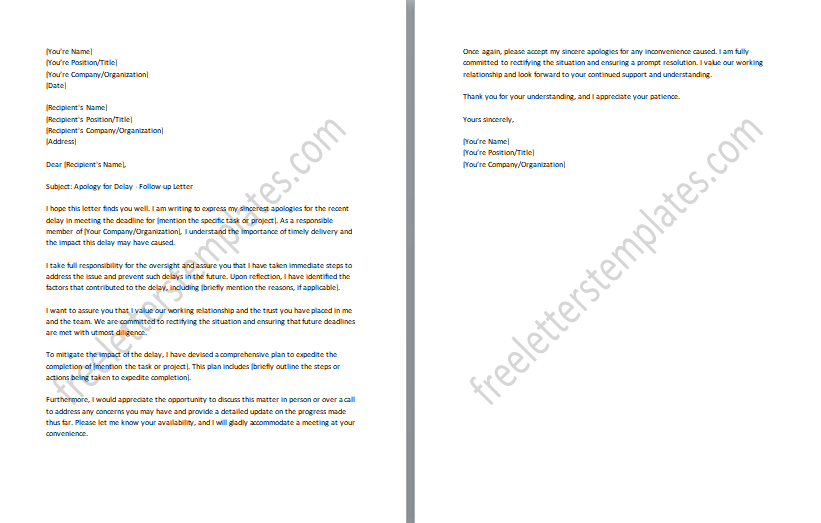
#2: Extension Request: Follow-up Letter
The Extension Request: Follow-up Letter is a formal communication seeking an extension for a previously set deadline. This letter is used when circumstances arise that make it challenging or impossible to complete a task or project within the originally agreed-upon timeframe. The purpose of this letter is to explain the reasons for the extension request, provide any necessary supporting documentation or evidence, and highlight the potential impact of not granting the extension. It aims to convey professionalism, transparency, and a genuine commitment to delivering high-quality work by requesting additional time to ensure a satisfactory outcome.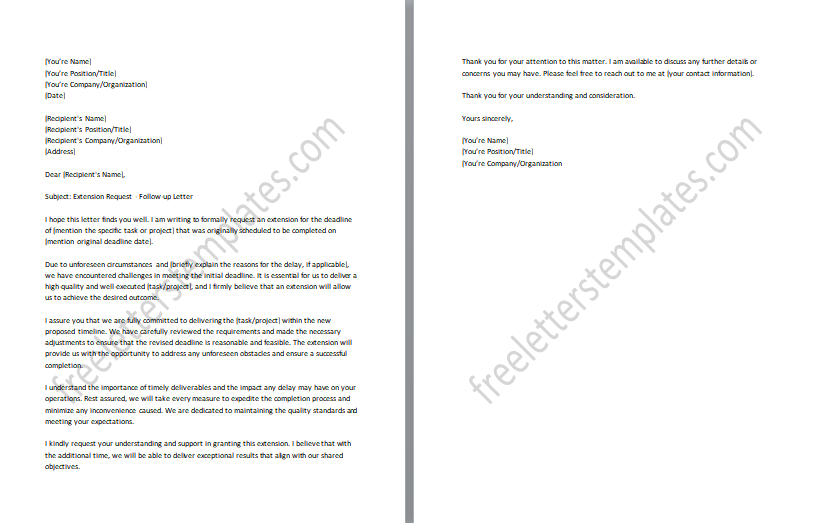
#3: Missed Deadline: Acknowledgment Letter
The Missed Deadline: An acknowledgment Letter is a formal communication sent to acknowledge and address a missed deadline. This letter serves to acknowledge the delay and express an understanding of the impact it may have had on the recipient or the overall project. The purpose of this letter is to demonstrate accountability, take responsibility for the delay, and assure the recipient that the situation is being addressed. It aims to maintain open lines of communication, establish transparency, and set the foundation for discussing any necessary actions, adjustments, or recovery plans to mitigate the effects of the missed deadline.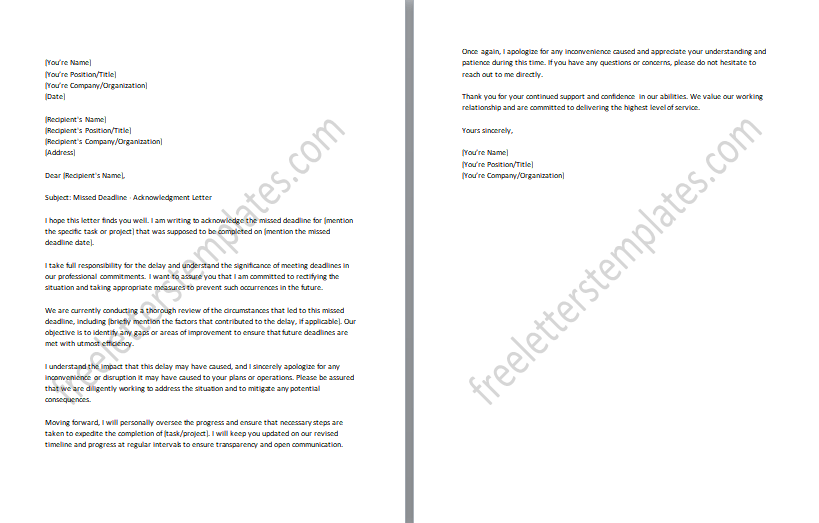
#4: Revised Timeline: Follow-up Communication
The Revised Timeline: Follow-up Communication is a brief and concise communication that informs stakeholders or team members about a revised timeline for a project or task. This communication is necessary when there are changes in the original schedule due to various factors such as delays, resource constraints, or unexpected circumstances. The purpose of this communication is to provide clarity and transparency by informing all relevant parties about the updated timeline, ensuring that everyone is aware of the new deadlines and can adjust their plans accordingly. It helps to manage expectations, maintain alignment, and facilitate effective coordination among team members or stakeholders involved in the project.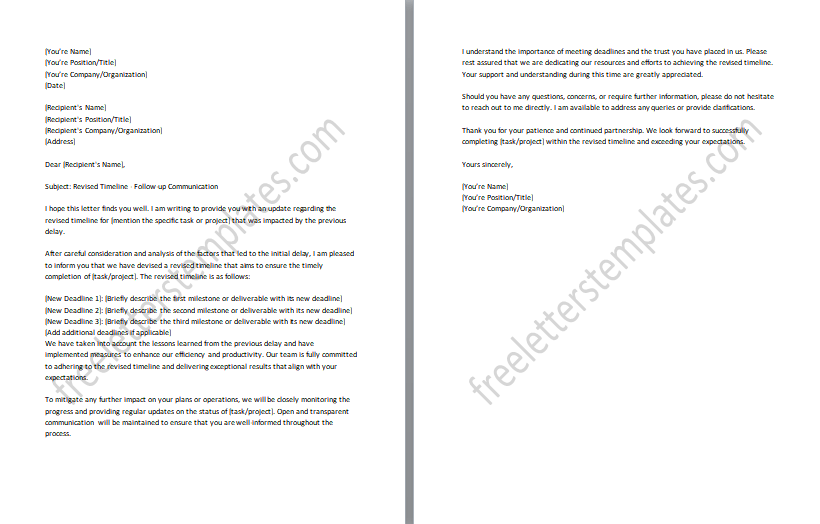
#5: The explanation for the Delay: Follow-up Correspondence
When it comes to the Explanation for Delay: Follow-up Correspondence, it’s all about being open and transparent in our communication. We understand the importance of providing a thorough and genuine explanation for any delays that may have occurred in our work. Sometimes unforeseen challenges or resource limitations can arise, impacting our ability to meet the initial deadline. In this correspondence, we aim to provide you with a human-like tone, sharing the truth about the situation and any external factors that may have contributed to the delay. Our goal is to foster understanding and maintain trust by being forthright about the challenges we encountered and our commitment to resolving them promptly.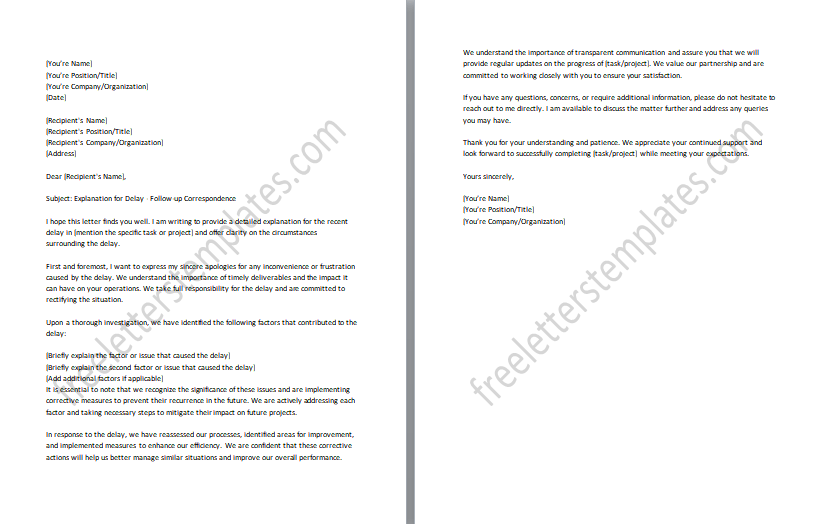
#6: Assurance of Completion: Follow-up Letter
The Assurance of Completion: A follow-up Letter is a concise communication that seeks to reassure the recipient about the successful completion of a task or project despite a previous delay or setback. The purpose of this letter is to instill confidence and provide assurance that the necessary measures are being taken to ensure the project’s completion within the revised timeline. It aims to convey a sense of commitment, accountability, and proactive action by outlining the steps being taken to overcome any obstacles or challenges that caused the initial delay. This letter is intended to alleviate concerns, maintain trust, and reinforce the organization’s dedication to delivering a high-quality outcome.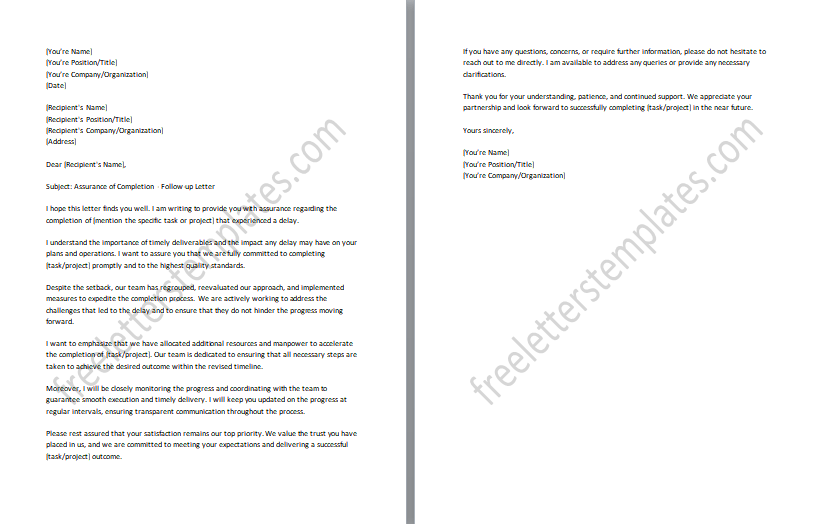
#7: Updated Project Plan: Follow-up Communication
The Updated Project Plan: Follow-up Communication serves as a concise communication that shares a revised project plan with relevant stakeholders. This communication is necessary when adjustments are made to the original project plan due to changes in scope, priorities, resources, or timelines. The purpose of this communication is to ensure that all stakeholders are informed of the updated project plan, providing clarity on the new direction and expectations. It aims to facilitate effective coordination, alignment, and collaboration among team members or stakeholders by providing a clear roadmap for the project moving forward. By sharing the updated project plan, this communication fosters transparency, enables better decision-making, and helps stakeholders stay on track toward project success.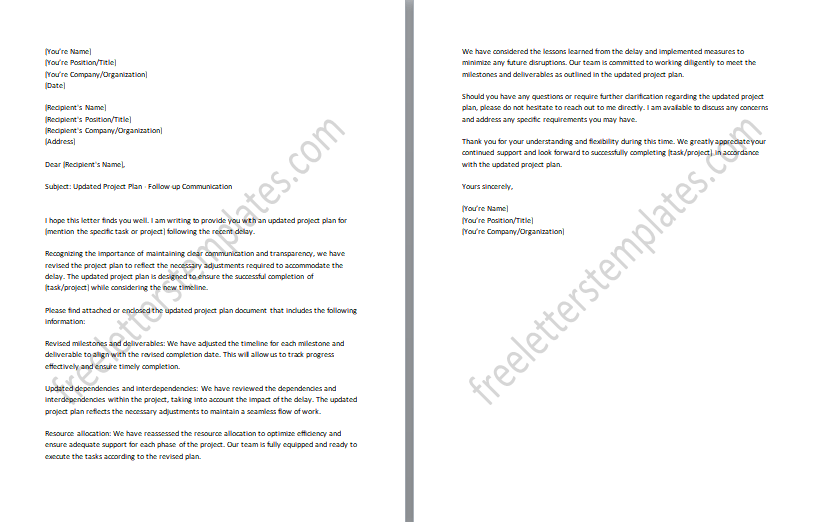
#8: Seeking Guidance: Missed Deadline Follow-up
When it comes to the Seeking Guidance: Missed Deadline Follow-up, we aim to reach out to the individuals and stakeholders involved sincerely and humbly. We understand the importance of acknowledging the missed deadline and taking responsibility for it. We genuinely value the insights and guidance of others, which is why we are seeking their support and expertise. We want to learn from this experience and improve our processes moving forward. By reaching out for guidance, we hope to foster open and collaborative communication, tapping into the collective knowledge and wisdom of our team and stakeholders. Together, we can find solutions, prevent future delays, and ensure better project outcomes.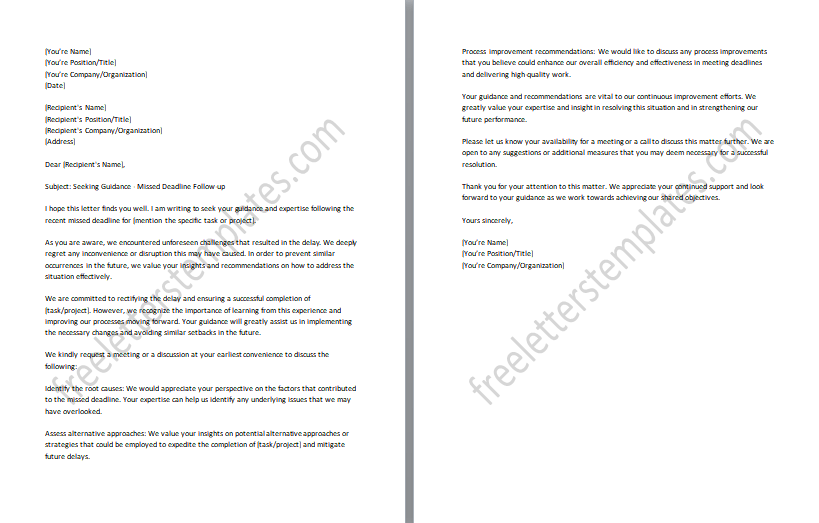
#9: Proposed Solutions: Delay Follow-up Letter
The “Proposed Solutions: Delay Follow-up Letter” is a thoughtful and proactive communication that presents potential solutions to address a delay in a project or task. This letter is designed to demonstrate a proactive approach to resolving the delay and minimizing its impact. The purpose of this letter is to offer well-considered solutions that can help expedite the project’s progress and mitigate any negative consequences. It aims to showcase problem-solving skills, initiative, and a commitment to delivering the best possible outcome. By presenting proposed solutions, this letter encourages open dialogue, collaboration, and decision-making among stakeholders to collectively determine the best course of action to overcome the delay and ensure successful project completion.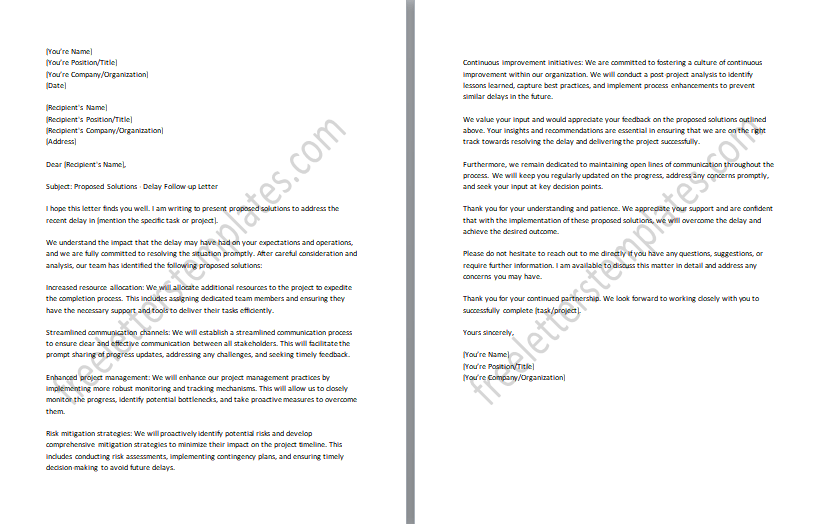
#10: Mitigation Measures: Deadline Follow-up
The purpose of this letter is to provide a summary of the usage and importance of mitigation measures, specifically addressing the need for deadline follow-up. Mitigation measures refer to actions taken to reduce or prevent risks and damages in various contexts, such as environmental, health, or project management. It highlights the need for proactive communication, accountability, and adherence to deadlines as critical components of successful mitigation strategies. By maintaining a systematic approach to deadline follow-up, organizations can enhance efficiency, mitigate potential delays, and minimize the impact of risks, ultimately leading to improved project outcomes and overall success.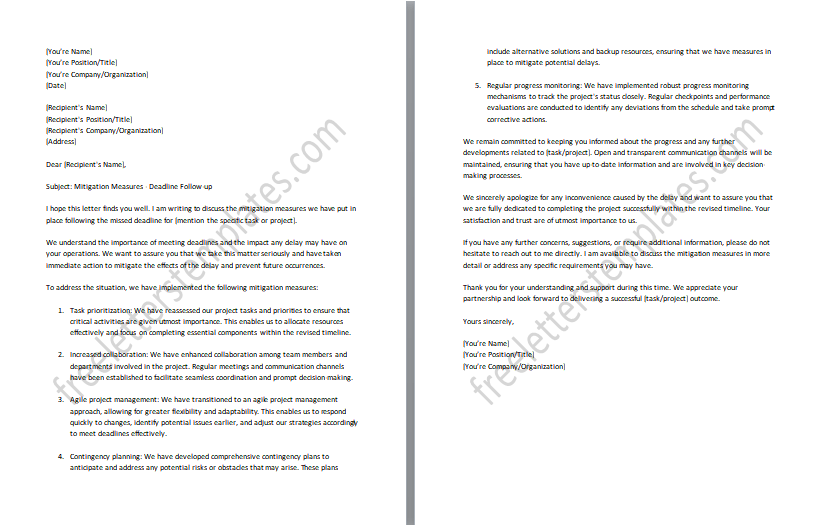
#11: Revised Milestones: Follow-up Letter
The purpose of this follow-up letter is to address and provide a summary of the usage and importance of communicating revised milestones. Revised milestones refer to the updated targets or objectives set for a project or initiative due to changes in circumstances, resources, or priorities. This letter emphasizes the significance of promptly communicating revised milestones to all relevant stakeholders to ensure clarity, alignment, and effective project management. It highlights the importance of transparent and proactive communication in managing expectations, maintaining accountability, and facilitating informed decision-making. By promptly sharing revised milestones, organizations can foster trust, enable collaboration, and adapt to changing circumstances, ultimately increasing the likelihood of project success and achieving desired outcomes.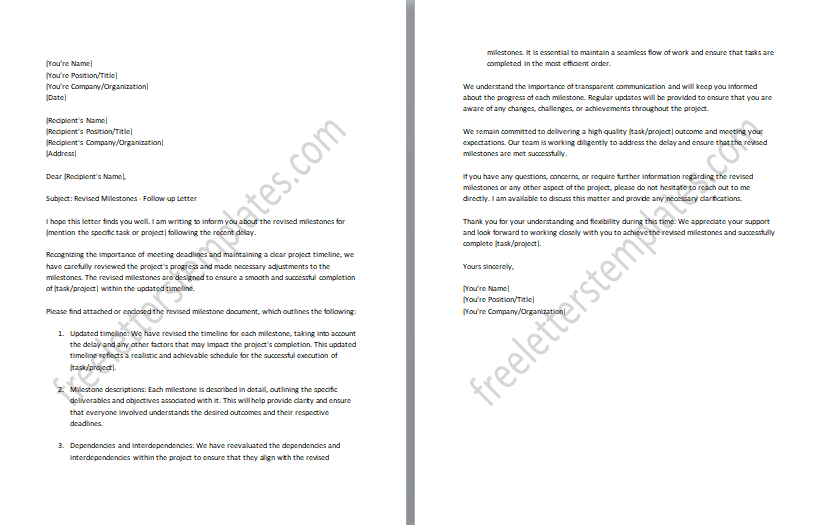
#12: Addressing Impacts: Missed Deadline Letter
The purpose of this letter is to address and provide a summary of the usage and importance of addressing impacts in the context of missed deadlines. When a deadline is not met, it can have various implications on a project, such as delays, resource allocation challenges, and potential financial or reputational impacts. This letter emphasizes the significance of promptly acknowledging and addressing the impacts of missed deadlines to mitigate negative consequences and ensure effective project management. By addressing the impacts of missed deadlines proactively, organizations can minimize disruptions, regain stakeholder confidence, and work towards achieving project objectives promptly.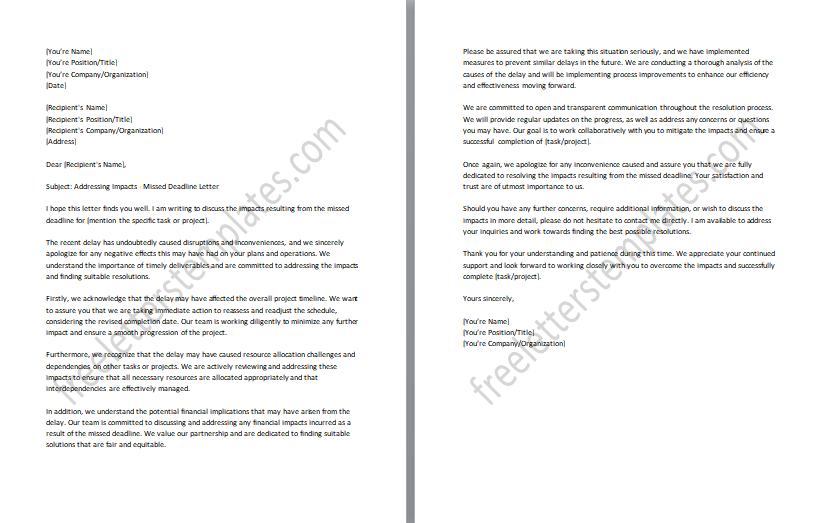
#13: Additional Resources: Follow-up Request
The purpose of this follow-up request is to address and provide a summary of the usage and importance of seeking additional resources. In various contexts, organizations may encounter situations where the available resources may be insufficient to meet the demands of a project, task, or objective. This letter emphasizes the significance of requesting additional resources in a timely and proactive manner to ensure successful project execution. By seeking additional resources, organizations can enhance productivity, overcome limitations, and optimize their ability to meet project goals effectively. This request aims to demonstrate a proactive approach to resource management and facilitate the allocation of necessary resources to ensure project success.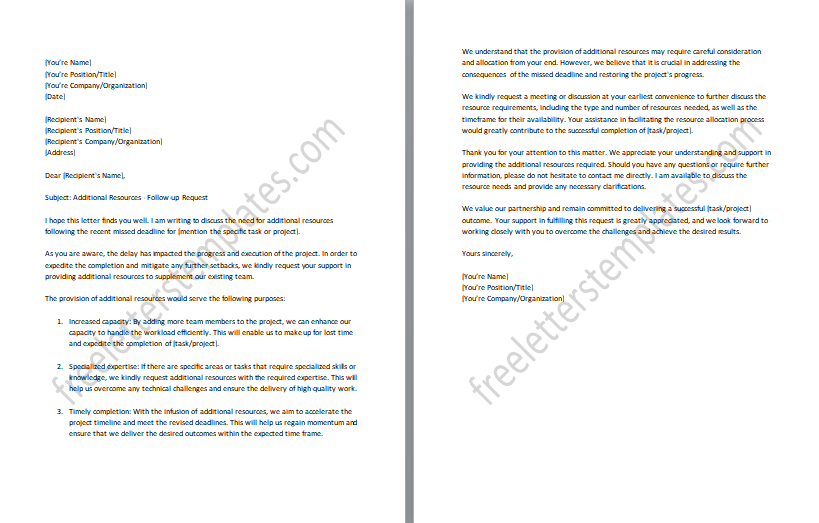
#14: Support Request: Delay Follow-up Letter
The purpose of this letter is to provide a summary of the usage and importance of requesting support in the context of a project delay. When a project faces a delay, it can have various impacts on the overall timeline and successful completion. This letter emphasizes the significance of reaching out for support clearly and concisely to address the delay effectively. It highlights the importance of explaining the reasons for the delay, outlining the specific areas where assistance is needed, and proposing potential solutions or strategies to mitigate the delay. This request aims to foster open communication, teamwork, and problem-solving to ultimately achieve project objectives and deliver successful outcomes.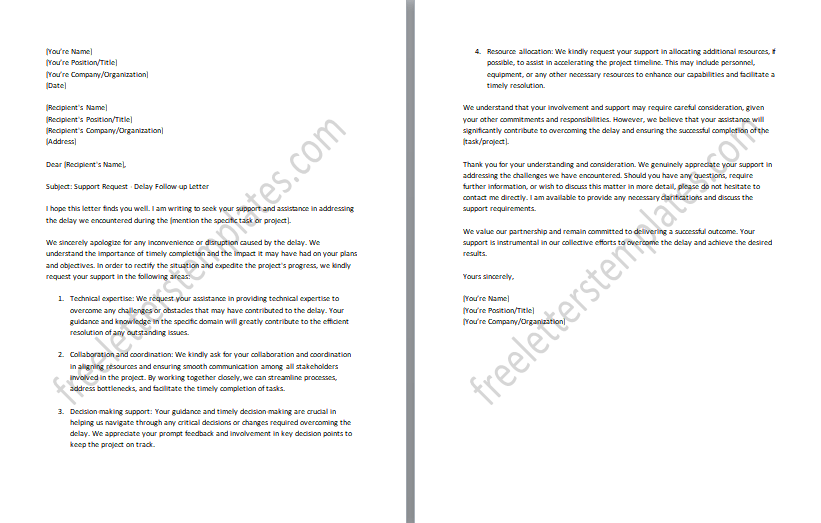
#15: Lessons Learned: Missed Deadline Discussion
The purpose of this missed deadline discussion is to summarize the usage and importance of conducting lessons learned sessions. This discussion emphasizes the significance of engaging in a lessons-learned session to analyze the factors contributing to the missed deadline, identify areas for improvement, and implement corrective measures. By conducting a thorough analysis of the missed deadline, organizations can identify root causes, adjust project plans, refine processes, and enhance future project management practices. This discussion serves as a platform for continuous improvement, enabling organizations to learn from their mistakes, avoid similar pitfalls, and ultimately increase the likelihood of meeting future deadlines successfully.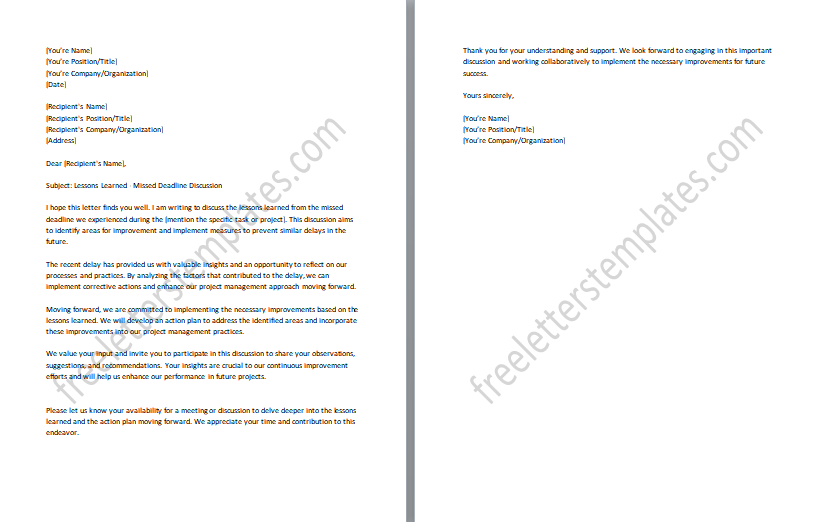
#16: Process Improvements: Deadline Follow-up
The purpose of this follow-up is to address and provide a summary of the usage and importance of implementing process improvements in the context of deadline follow-up. This follow-up emphasizes the significance of evaluating the existing processes, identifying bottlenecks or inefficiencies, and implementing changes to enhance productivity and meet future deadlines successfully. It highlights the importance of conducting a thorough analysis, involving key stakeholders, and prioritizing areas that require improvement. By implementing process improvements, organizations can streamline workflows, optimize resource allocation, enhance communication and collaboration, and ultimately increase the chances of meeting deadlines effectively. This follow-up encourages a proactive approach to project management, fostering a culture of continuous improvement and increasing the overall success rate of future projects.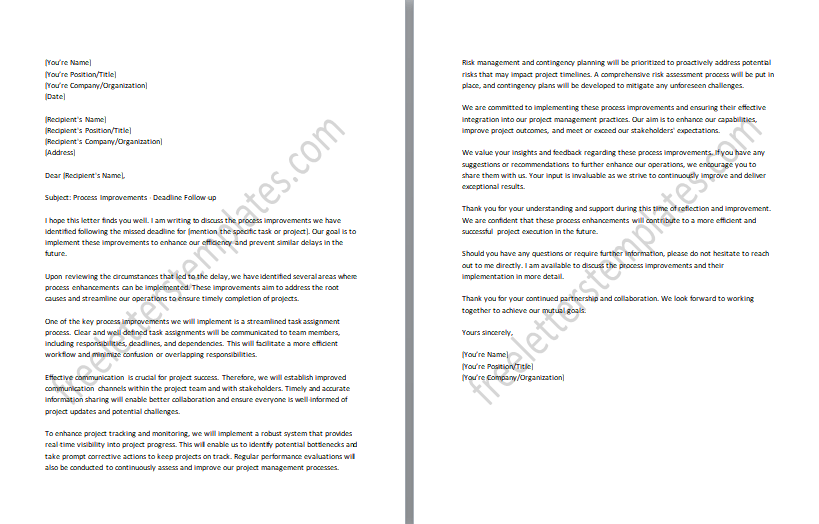
#17: Review Request: Revised Schedule Follow-up
The purpose of this follow-up letter is to address and provide a summary of the usage and importance of requesting a review of a revised schedule. This letter emphasizes the significance of engaging relevant stakeholders in the review process to ensure alignment, accuracy, and feasibility of the revised schedule. It highlights the importance of proactive communication, transparently presenting the reasons for the changes, and seeking input and feedback from key individuals involved in the project. By requesting a review of the revised schedule, organizations can validate the proposed timeline, identify potential conflicts or dependencies, and make necessary adjustments to optimize project planning and execution. This review request aims to facilitate collaboration, enhance project coordination, and increase the chances of meeting project milestones and objectives effectively.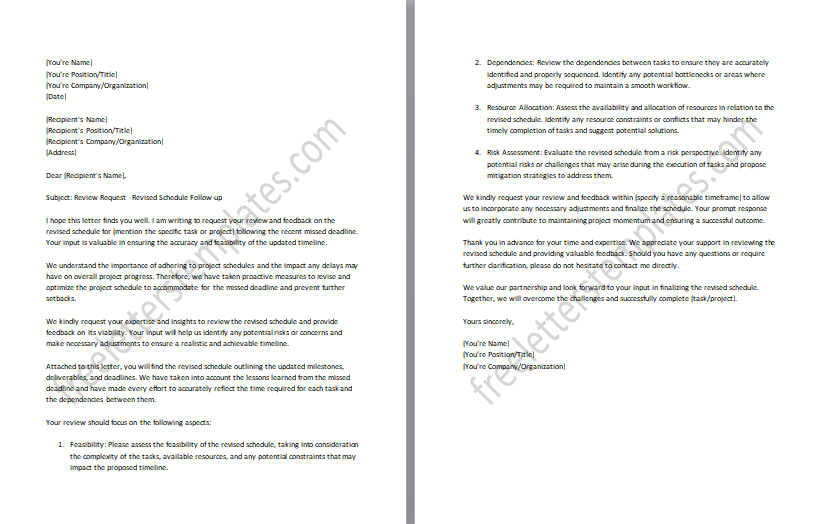
#18: Resource Reallocation: Catching Up on Delay
The purpose of this letter is to provide a summary of the usage and importance of resource reallocation when catching up on a project delay. This letter emphasizes the significance of strategically reallocating resources to areas that require additional support or attention. It highlights the importance of identifying critical tasks, determining resource availability and capability, and making informed decisions to optimize resource allocation. By reallocating resources effectively, organizations can prioritize essential activities, streamline workflows, and increase productivity to catch up on the project delay. This approach aims to mitigate the impact of the delay, ensure efficient resource utilization, and ultimately accelerate progress toward project completion.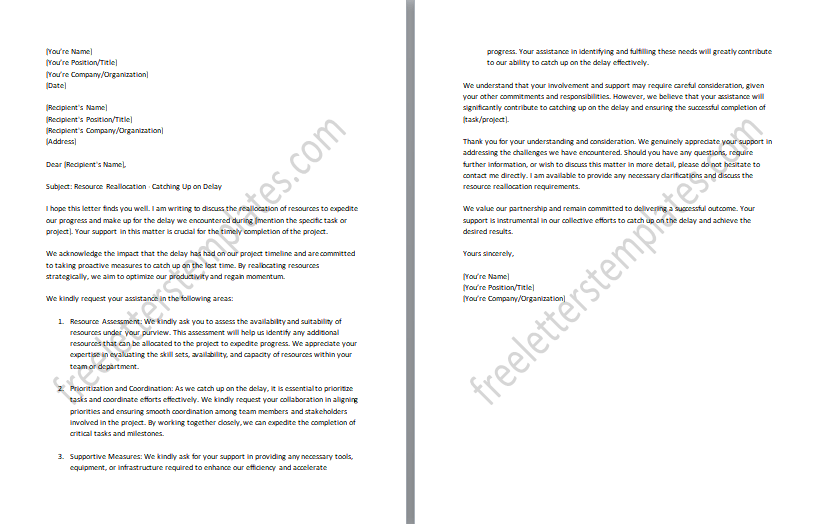
#19: Remedial Actions: Follow-up Meeting Request
The purpose of this follow-up meeting request is to address and provide a summary of the usage and importance of discussing remedial actions. This meeting request emphasizes the significance of convening a discussion to evaluate the situation, analyze the root causes of the issues, and propose effective remedial actions. It highlights the importance of involving key stakeholders, sharing insights and recommendations, and fostering collaboration to collectively address the challenges at hand. This meeting request aims to facilitate open dialogue, problem-solving, and decision-making, ultimately driving the project forward and achieving desired outcomes.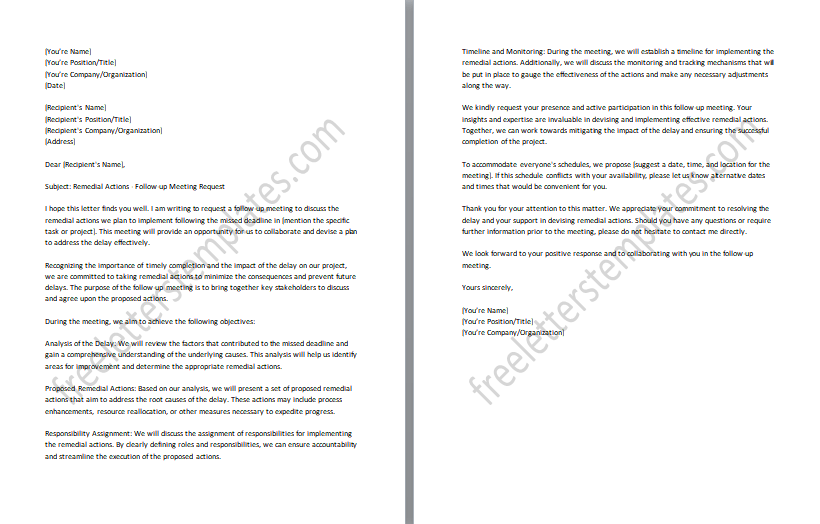
#20: Updated Deliverables: Follow-up Letter
The purpose of this follow-up letter is to emphasize the importance of promptly communicating updated deliverables to ensure effective project management. Transparent and proactive communication is crucial for managing expectations, maintaining stakeholder engagement, and facilitating informed decision-making. By sharing updated deliverables, organizations ensure that all stakeholders are aware of changes, their impact on the project, and any necessary adjustments. This fosters trust, collaboration, and a shared understanding of evolving project needs, leading to successful delivery and stakeholder satisfaction. Effective communication of updated deliverables enables organizations to adapt to changes, align their efforts, and ultimately achieve project objectives with efficiency and clarity.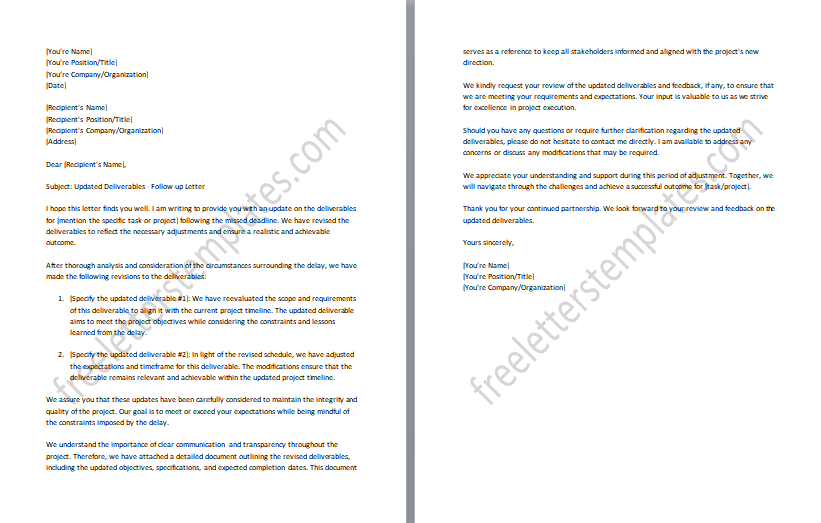
#21: Commitment to Deadlines: Follow-up Communication
The purpose of this follow-up communication is to reaffirm the commitment to deadlines and emphasize their importance in project management. This communication emphasizes the significance of honoring and meeting deadlines to ensure the successful completion of tasks and milestones. It highlights the importance of accountability, proactive planning, and effective time management in achieving project goals. By reiterating the commitment to deadlines, organizations can foster a culture of responsibility, drive productivity, and maintain stakeholder confidence. This communication aims to reinforce the importance of meeting deadlines, inspire a sense of urgency, and encourage collaborative efforts to ensure timely project delivery and overall success.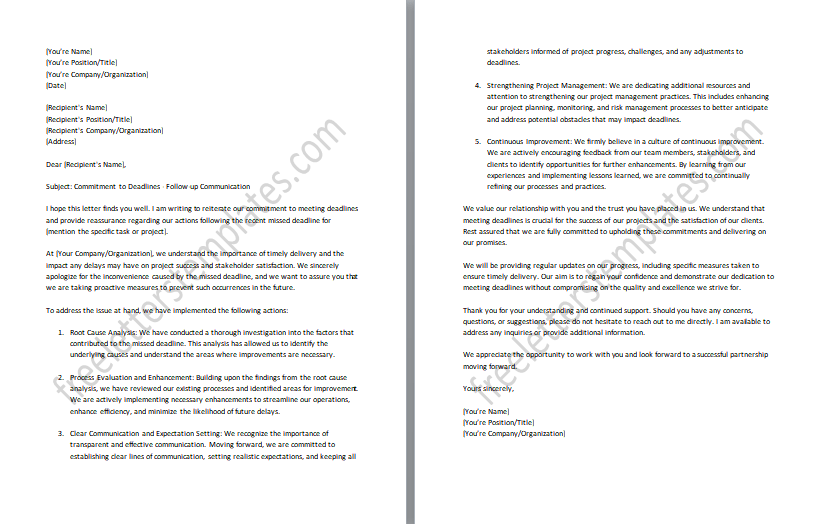
#22: Collaborative Recovery: Delay Follow-up
The purpose of this follow-up communication is to address and provide a summary of the usage and importance of collaborative recovery efforts in response to a project delay. When a project experiences a delay, it is crucial to foster collaboration and engage all stakeholders in the recovery process. It highlights the importance of open communication, shared accountability, and proactive problem-solving to mitigate the delay and get the project back on track. By promoting a collaborative recovery approach, organizations can harness the collective knowledge, skills, and resources of the team to expedite progress, minimize further delays, and achieve successful project outcomes. This communication aims to foster teamwork, trust, and a shared commitment to overcome challenges and deliver results.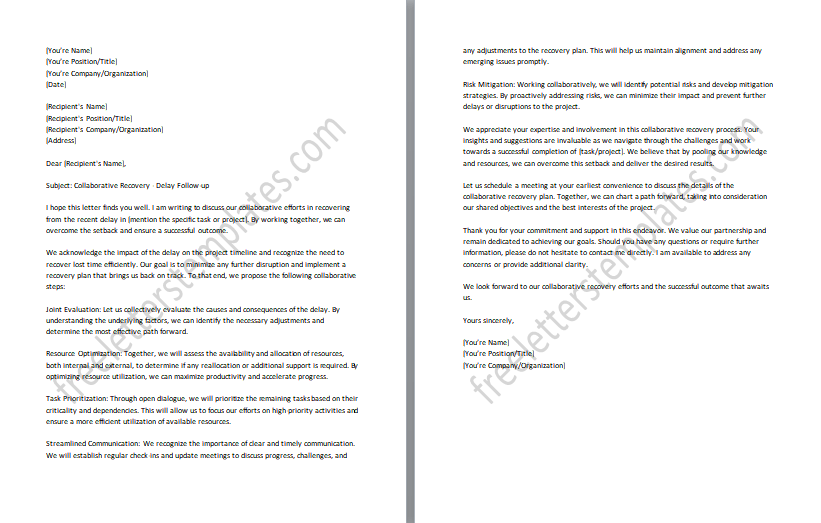
#23: Stakeholder Communication: Missed Deadline Letter
The purpose of this letter is to address and provide a summary of the usage and importance of stakeholder communication in the context of a missed deadline. This letter emphasizes the significance of acknowledging the missed deadline, explaining the reasons for the delay, and outlining the plan to mitigate the impact and move forward. It highlights the importance of proactive communication to maintain stakeholder trust, manage expectations, and demonstrate commitment to project success. By effectively communicating the situation, organizations can foster understanding, address concerns, and work collaboratively with stakeholders to find solutions and realign project goals. This letter aims to strengthen relationships, maintain open lines of communication, and ultimately navigate the challenges of a missed deadline successfully.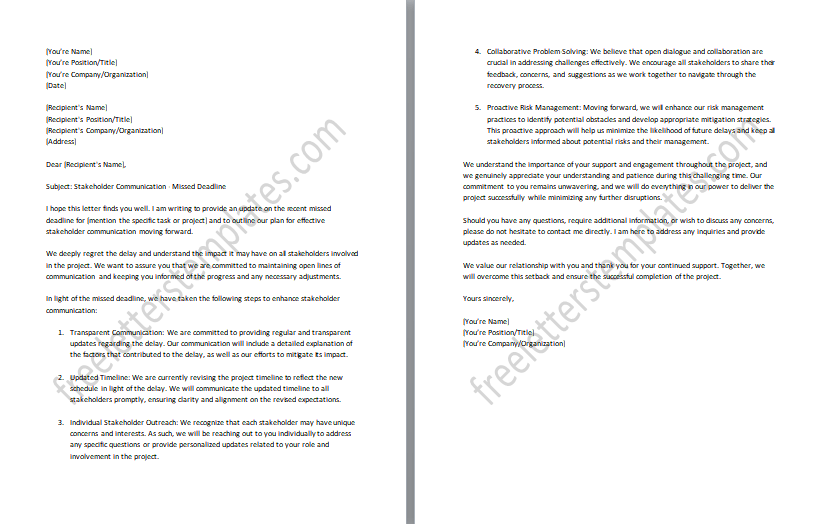
#24: Follow-up Meeting Request: Missed Deadline
The purpose of this follow-up meeting request is to address and provide a summary of the usage and importance of scheduling a meeting to discuss a missed deadline. This meeting request emphasizes the significance of engaging key stakeholders in a collaborative discussion to understand the reasons behind the missed deadline and collectively find solutions. It highlights the importance of open communication, sharing lessons learned, and developing an action plan to prevent similar delays in the future. By scheduling a follow-up meeting, organizations can demonstrate their commitment to resolving issues, foster accountability, and ensure a proactive approach to project management. This meeting request aims to promote collaboration, and problem-solving, and ultimately drive the project toward successful completion.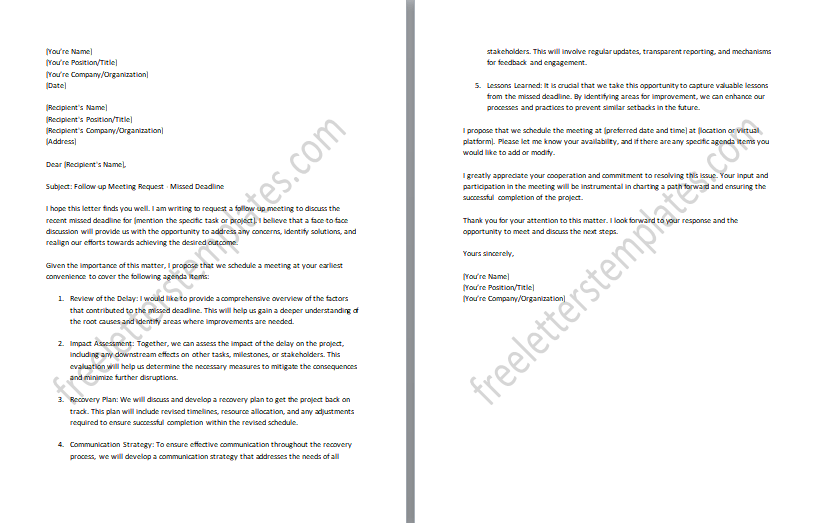
Time Management Techniques
- Prioritize Tasks: Use techniques like Eisenhower Matrix or ABC Analysis to categorize tasks based on their urgency and importance. Focus on completing high-priority tasks first.
- Set Clear Goals: Define specific, measurable, attainable, relevant, and time-bound (SMART) goals to provide clarity and direction. Break down larger goals into smaller, manageable tasks.
- Create a To-Do List: Maintain a daily or weekly to-do list to track tasks and prioritize them accordingly. Update and review the list regularly to stay organized and ensure nothing falls through the cracks.
- Utilize Time Blocking: Allocate specific time blocks for different types of activities or tasks. This helps create a structured schedule and minimizes distractions.
- Pomodoro Technique: Break work into intervals, typically 25 minutes of focused work followed by a short break. Repeat this cycle several times, and then take a more extended break. This technique enhances focus and productivity.
- Eliminate Time Wasters: Identify and eliminate or minimize activities that consume time without adding value, such as excessive social media use, unnecessary meetings, or multitasking.
- Delegate Tasks: Delegate tasks that can be handled by others, freeing up your time for more critical responsibilities. Ensure proper communication and provide clear instructions when delegating.
- Use Productivity Tools: Explore productivity tools such as task management apps, project management software, or calendar tools to streamline workflows, set reminders, and track progress.
- Practice Time Discipline: Stick to set schedules and deadlines, avoiding procrastination. Develop self-discipline and hold yourself accountable for managing time effectively.
- Limit Distractions: Minimize interruptions by turning off notifications, creating a dedicated workspace, and establishing boundaries with colleagues or family members.
- Take Regular Breaks: Allow for short breaks during work sessions to recharge and maintain focus. Stepping away from work periodically can enhance productivity and prevent burnout.
- Learn to Say No: Prioritize your workload and be selective about taking on additional tasks or commitments. Learn to say no when necessary to protect your time and maintain a work-life balance.
- Reflect and Learn: Regularly reflect on your time management practices, evaluate what worked well, and identify areas for improvement. Learn from past experiences to refine your approach.
Team Collaboration and Accountability
Fostering Collaborative Work Environment:
- Encourage open communication and active participation among team members.
- Promote a culture of trust, respect, and collaboration.
- Foster a supportive and inclusive work environment that values diverse perspectives and encourages teamwork.
- Provide opportunities for team members to collaborate on tasks and projects, fostering a sense of collective ownership.
Promoting Ownership of Tasks:
- Clearly define roles, responsibilities, and expectations for each team member.
- Encourage individuals to take ownership of their assigned tasks and deliverables.
- Empower team members to make decisions and take initiative within their areas of expertise.
- Foster a sense of pride and accountability for the quality and timely completion of tasks.
Establishing a Culture of Accountability:
- Set clear and measurable goals and deadlines for projects and tasks.
- Regularly track and monitor progress toward goals, and provide feedback and support as needed.
- Encourage team members to take responsibility for their actions and outcomes.
- Celebrate achievements and recognize individuals and teams for meeting deadlines and delivering high-quality work.
Effective Communication:
- Encourage open and transparent communication channels within the team.
- Foster active listening, understanding different perspectives, and promoting constructive feedback.
- Clearly communicate deadlines, priorities, and expectations to ensure everyone is aligned.
- Regularly provide updates on progress, challenges, and any changes that may impact deadlines.
Collaboration Tools and Technology:
- Implement collaborative tools and project management software to facilitate communication, task tracking, and collaboration.
- Use shared calendars, document-sharing platforms, and task management systems to keep everyone informed and organized.
- Encourage the use of real-time collaboration features to streamline work processes and enhance teamwork.
Conclusion:
In conclusion, follow-up letters play a critical role in addressing missed deadlines effectively and ensuring successful project outcomes. By maintaining communication, addressing concerns, and outlining plans for recovery, follow-up letters help foster transparency, rebuild trust, and manage stakeholder expectations. They serve as a valuable tool for documenting communication, setting expectations, and promoting collaboration among team members and stakeholders. Additionally, our website provides a wealth of resources, including sample letters, best practices, time management techniques, and tips for fostering team collaboration and individual accountability. We aim to empower individuals and organizations with the knowledge and tools they need to navigate the challenges of missed deadlines, learn from experiences, and ultimately enhance project performance. By leveraging the power of follow-up letters and implementing effective strategies, we can transform missed deadlines into opportunities for growth, improvement, and project success.